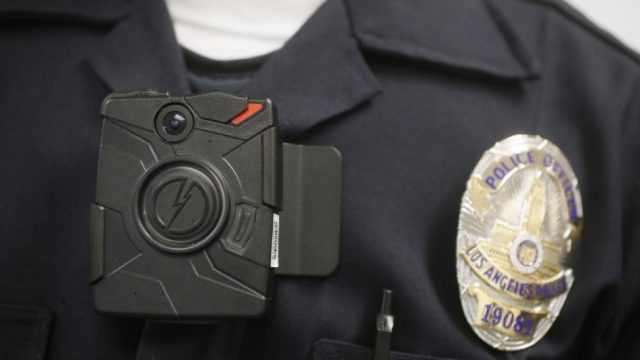Matt Evans: Cops Should Buy More Cameras Not More Firepower

The police departments in the US appear to have plenty of military weaponry. Machine pistols, body armor, helmets, armored vehicles, grenades, etc. This is strange because it is not often that a police department shows up somewhere and needs more firepower than their service sidearms. There have been just a handful of occasions in US history, usually decades apart, where bad guys were able to out-gun the law enforcement. The LA bank robbery of the late 90s, and the Miami shootings of the 80s both changed police doctrine because the bad guys had the good guys outgunned. Apart from those events, the police seem to have things covered.
Equipping each officer with body armor, and each squad car with a shotgun and a rifle, more than meets the needs of domestic law enforcements most severe cases. I think it is safe to say that the offensive and defensive equipment of many departments is more than sufficient to cover their legitimate needs.
What many departments seem to be missing, however, is accountability, and the ability to satisfyingly resolve situations of alleged police misconduct. Police don’t seem to be getting into long shootouts or standoffs with heavily armed opposing forces. Police DO seem to be beating and killing folks, and then getting into he-said / she-said arguments with the public and the court.
A legitimate, responsible organization that is well managed and spends its resources effectively to deal with the threats that it faces most often would stop, at this point, spending money on more firepower, and start spending money on cameras.
The easiest way for officers to exonerate themselves, and to quiet the criticisms of the public, and to identify officers on the force who are public relations disasters waiting to happen, would be to put a dash cam in every car and a head or helmet cam on every officer.
Video evidence of citizen encounters protects the officers. Good cops can rely on video evidence that exonerates them when they are accused of assaulting someone during an arrest. Good cops can rely on video evidence that shows they kept their hands off of female suspects, or reacted in a reasonable way when dealing with an unruly female who later claimed she was assaulted. Angry citizens file misconduct reports against officers. Some of them are legitimate and some of them aren’t. In both cases, video should help. It should support the legitimate claims and it should dismiss the false ones.
Good cops can rely on video that shows that the unarmed teen that everybody loved, actually was behaving erratically and aggressively, and provoked a tragic defensive response from the officers.
This last point is especially important this week, as we watch the escalating violence in the community of Ferguson, MO. The community believes the police killing of a young man was unwarranted. The police aren’t saying yet. Video from the responding officers would quickly get to the heart of the matter.
Instead, members of the Ferguson community are filming the police response, and the local police aren’t happy about it. There are reports that reporters are being asked to leave, and that cell phone signals in the area are being jammed. This is a recipe for disaster. In situations where the police are attempting to manage crowds of angry community members, we need more video, not less.
GoPro cameras, and other similar digital movie cameras, have no moving parts and are rated and designed for harsh conditions. Some models can be had for under $100. It would take less money to outfit each officer with a GoPro style camera than it would to buy each officer an additional service weapon.
Many departments in the US have installed squad car dash cameras, and those who have done so have had great results — both for officers who behave appropriately as well as for citizens who were wrongfully accused.
Back when the bill of rights was being considered, we didn’t have video cameras, we only had guns. The failsafe way for citizens to deal with a military that was oppressing them was the force of arms, and therefore, the second amendment, which protects individual ownership of the means of defense against government misconduct, was written into our bill of rights.
But this is 2014, and while firearms haven’t evolved much, personal video technology has. It is now cheaper to give every cop a camera than it is to give every cop a gun.
Finally – the problem of violent clashes between police and citizens, and the resultant outrage of angry citizens objecting to what they felt was police misconduct, is nothing new. John Adams, one of the founding fathers of the US, and second president of the United States, was a famous lawyer in Boston in the pre-revolutionary period. The trial that he is perhaps the most famous for is when he defended eight British soldiers who were accused of perpetrating the Boston Massacre.
Then, as now, video evidence could have done much to show both the angry mob and the beleaguered law enforcement the reality of what had transpired.
It’s time for cooler heads to prevail. It’s time for the police to use video evidence to expose citizen misbehavior, and it’s time for the citizens to use video evidence to expose police misbehavior.




